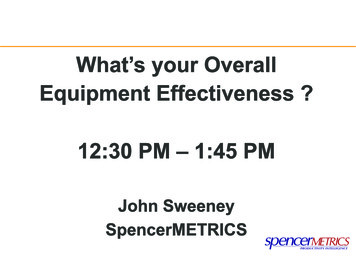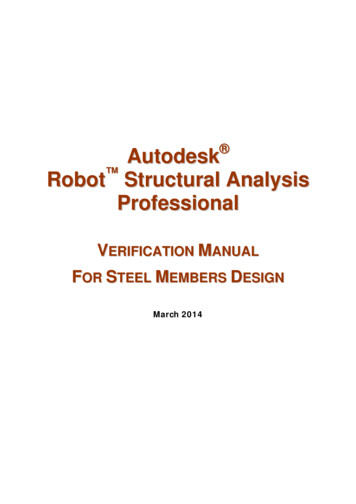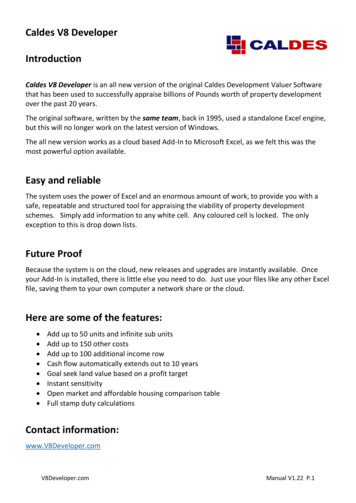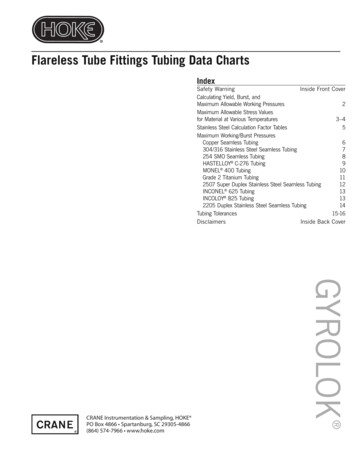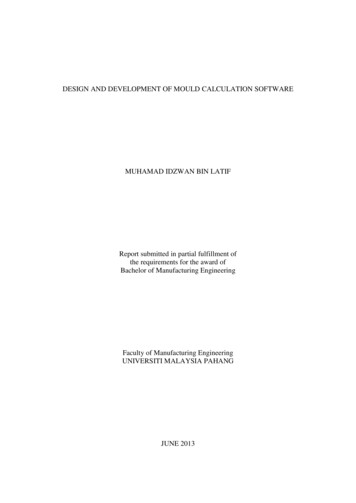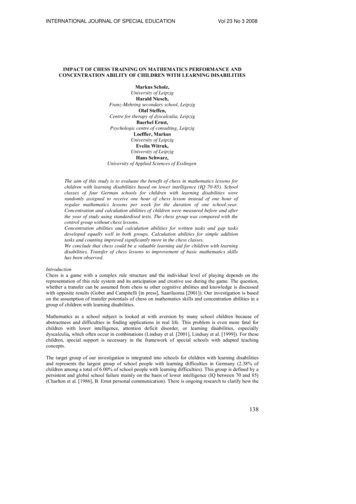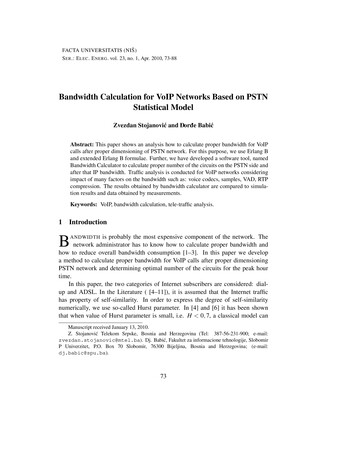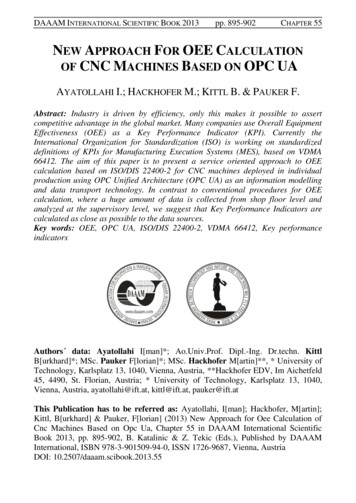
Transcription
DAAAM INTERNATIONAL SCIENTIFIC BOOK 2013pp. 895-902CHAPTER 55NEW APPROACH FOR OEE CALCULATIONOF CNC MACHINES BASED ON OPC UAAYATOLLAHI I.; HACKHOFER M.; KITTL B. & PAUKER F.Abstract: Industry is driven by efficiency, only this makes it possible to assertcompetitive advantage in the global market. Many companies use Overall EquipmentEffectiveness (OEE) as a Key Performance Indicator (KPI). Currently theInternational Organization for Standardization (ISO) is working on standardizeddefinitions of KPIs for Manufacturing Execution Systems (MES), based on VDMA66412. The aim of this paper is to present a service oriented approach to OEEcalculation based on ISO/DIS 22400-2 for CNC machines deployed in individualproduction using OPC Unified Architecture (OPC UA) as an information modellingand data transport technology. In contrast to conventional procedures for OEEcalculation, where a huge amount of data is collected from shop floor level andanalyzed at the supervisory level, we suggest that Key Performance Indicators arecalculated as close as possible to the data sources.Key words: OEE, OPC UA, ISO/DIS 22400-2, VDMA 66412, Key performanceindicatorsAuthors data: Ayatollahi I[man]*; Ao.Univ.Prof. Dipl.-Ing. Dr.techn. KittlB[urkhard]*; MSc. Pauker F[lorian]*; MSc. Hackhofer M[artin]**, * University ofTechnology, Karlsplatz 13, 1040, Vienna, Austria, **Hackhofer EDV, Im Aichetfeld45, 4490, St. Florian, Austria; * University of Technology, Karlsplatz 13, 1040,Vienna, Austria, ayatollahi@ift.at, kittl@ift.at, pauker@ift.atThis Publication has to be referred as: Ayatollahi, I[man]; Hackhofer, M[artin];Kittl, B[urkhard] & Pauker, F[lorian] (2013) New Approach for Oee Calculation ofCnc Machines Based on Opc Ua, Chapter 55 in DAAAM International ScientificBook 2013, pp. 895-902, B. Katalinic & Z. Tekic (Eds.), Published by DAAAMInternational, ISBN 978-3-901509-94-0, ISSN 1726-9687, Vienna, AustriaDOI: 10.2507/daaam.scibook.2013.55
Ayatollahi, I.; Hackhofer, M.; Kittl, B. & Pauker, F.: New Approach for Oee Calcul.1. IntroductionIn the manufacturing industry Overall Equipment Effectiveness (OEE) is usedas a common key figure for manufacturing facilities. OEE as a measurement methodis part of the Total Productive Maintenance (TPM) concept. It was first implemented1971 at Nippondenso Co. which was member of the Toyota Group (Reichel et al.,2009). The OEE has been proven in thousands of companies. It exposes relentlesslylosses and helps eliminating them (Koch, 2011). It presents a key figure which iscomposed of the factors availability, effectiveness and quality rate. Usually the OEEis applied for mass production and only in few exceptions for individual production.Due to the lack of a precise OEE definition, many derivations evolved in the lastyears, among them the following exist: “Overall line effectiveness” (OLE) (Nachiappan and Anantharaman, 2006) “Overall equipment effectiveness of a manufacturing line” (OEEML) (Braglia etal., 2008) “Overall plant effectiveness” (OPE) (Scott and Pisa, 1998) “Overall factory effectiveness” (OFE) (Oechsner et al., 2002) “Overall equipment effectiveness of a manufacturing line” (OEEML) (Braglia etal., 2008) “Overall fab effectiveness” (OFE) (Oechsner et al., 2002) “Determination of the overall equipment effectiveness for assembly systems onthe base of product data” (Neugebauer, R., 2010) “Stochastic overall equipment effectiveness“ (Zammori et al., 2011)All these methods follow their own definition on how to calculate the OEE.With ISO/DIS 22400-2 which is based on the VDMA 66412 published in 2009, a“Draft International Standard” is now available. The subcommittee 184 with workinggroup 9 of the International Organization for Standardization (ISO) works on thisstandard, which is currently guided as in “Enquiry stage” (ISO, n.d.). In ISO/DIS22400-2 the OEE is defined as follows:(1)(2)(3)(4)
DAAAM INTERNATIONAL SCIENTIFIC BOOK 2013pp. 895-902CHAPTER 55Fig. 1. Timeline for production units (ISO, n.d.)The OEE should be understood as aggregated information based on detailedinformation mostly created at the shop floor level. Therefore, machines asinformation providers should be able to evaluate relevant KPIs (e.g. effectiveness)and automatically deliver these indicators to higher-level systems or to machineoperators. This would correlate with the paradigm of service oriented architecture(SOA).1.1. Communication between Shop Floor and MESCurrently with VDI 5600 a guideline for communication between machines andMES is available which also considers existing standards from MESA, NAMUR,ISA, VDMA and ZVEI. The standard follows the requirement to be usable forheterogeneous machine parks in the manufacturing industry and does not followindustry-specific standards such as Weihenstephaner Standard, SECS/GEM,MTConnect (VDI, 2011). In VDI 5600 part 3 a well defined data structure forcommunication between a machine as a production resource and an MES System ispresented. Since the communication technology itself is not scope of VDI 5600, inthis paper OPC Unified Architecture (OPC UA) is suggested as a promisingspecification to facilitate semantic communication.1.2. OPC Unified Architecture (OPC UA)The most recent specification developed by the OPC Foundation – OPC UA –is capable of permeating the whole information and communication structure ofenterprises, and can be seen as a Service Oriented Architecture. “The purpose of OPCUnified Architecture was to enable a platform-independent interoperability standardfor moving data/information between the factory floor and the enterprise”(Mahnke etal., 2009). The previous standard of the OPC Foundation, the classic OPC, is widelyused in industry for data access and is still more common than the successor standard.
Ayatollahi, I.; Hackhofer, M.; Kittl, B. & Pauker, F.: New Approach for Oee Calcul.Fig. 2. Automation pyramid vs. new perceptionIn Fig. 2. the possible range of use of OPC UA and classic OPC is shown forinterfacing the layers of the automation pyramid from device level up to theenterprise level. With ISA-95 and OAGIS (“Open Applications Group,” n.d.) twoimportant standards for integrating applications based on service-orientedarchitecture are available (Gifford et al., 2006). Both provide a more cost-effectiveway for organizations to integrate their applications vertically in the information andcommunication technology view and should therefore be considered for OPC UAintegrations. Great hopes are placed in OPC UA as a new communication standardfor manufacturing systems, e.g. robotized manufacturing cells. Currently the fullfunctional volume of OPC UA is not yet used in the field of production engineering.At best it is used only as a wrapper for data access.2. Proposed ApproachTo comply with manufacturing enterprises’ demands, new approaches todetermine performance indicators are needed. The widespread automation pyramidshown in Fig. 2 represents a layer model of information technology for productionenterprises. It is based on the opposing trend of information quality versusinformation quantity. Today this model is not consistent with the reality anymore(Kegel, 2010). Due to the wide integration of information technology, a newreference model is required, that has to include the vertical and horizontal dimensionsof information flow as well as the life cycle of the product (Kegel, 2010).The presented approach for OEE calculation follows the paradigm of a ServiceOriented Architecture (SOA). In contrast to conventional procedures for OEEcalculation, where a huge amount of data is collected from shop floor level andanalyzed at the supervisory level, we suggest that Key Performance Indicators arecalculated as close as possible to the data sources.Fig. 3 shows the information flow between the supervisory system (MES) andthe shop floor for OEE evaluation, using the proposed approach. OEE is calculated inthe supervisory system from availability, quality ratio and effectiveness. Availabilityis the ratio of actual production time (APT) which can be delivered by the machine,and the planned busy time (PBT) which can be obtained from job shop scheduling.
DAAAM INTERNATIONAL SCIENTIFIC BOOK 2013pp. 895-902CHAPTER 55Quality ratio is calculated from good quantity (GQ) and produced quantity (PQ)delivered by order confirmation through shop floor data collection terminals.Effectiveness is based on data generated in the machine and will be calculated in themachine. We suggest the implementation of an OPC UA server in the machine toolcontrol allowing the supervisory system to query actual production time (APT) andeffectiveness for a given evaluation period through OPC UA method calls. The inputparameters are the start and end times of the evaluation period. They can be chosenby a machine operator or automatically by the MES (e.g. automatic evaluation ofeffectiveness for each job). APT and effectiveness are calculated using equations (5)and (6) for the given time interval using historized data on the OPC UA server.Fig. 3. Proposed information flow between MES and the shop floor2.1. Calculating the actual Production Time (APT)In case of CNC machine tools the machine status can be “inactive” (nomachining), “active” (machining in progress) or “fault” (machining interrupted). APTcan be understood as the time where machining is in progress. In Fig. 4 an exemplarysequence of relevant machine status changes is illustrated as a set of time slices. Eachtime slice represents either a production time (active) or a downtime (inactive orfault). Using equation (5) APT can be calculated with the given input values t start andtend. These values are first compared with the historized timestamps of the OPC UAvariable, which represents the machine status. The slices are then indexed as shownin Fig. 4. The time slice in which tstart or tend falls into are split to correspond to thegiven time horizon. For each slice the historized machine status is checked todetermine if the slice represents an inactive or fault period (ai 0) or an active period(ai 1).
Ayatollahi, I.; Hackhofer, M.; Kittl, B. & Pauker, F.: New Approach for Oee Calcul.Fig. 4. Example of time slices for evaluating APT(5)2.2. Calculation of EffectivenessFor evaluating the effectiveness according to equation (3) the product of plannedrun time per unit (PRU) and the produced quantity (PQ) is needed. For individualproduction the PRU is often roughly estimated or delivered by a CAM (ComputerAided Manufacturing) System as the result of machining simulation. We propose asimple solution instead. In case of CNC machining the planned run time can bedefined as the processing time with planned machining parameters. That is when themachine operates with programmed feed rates and when no unplanned interruptionsoccur. If the feed rates are changed by feed override during machining, the processingtime will obviously change. With knowledge about the feed override values and thetimestamps for feed override changes the “planned run time” (PRU * PQ) can becalculated using equation (6), with fi as the feed override value of time slice i( 0 fi 1.2) and ai {0, 1}.(6)Fig. 5. Example of time slices for calculating effectiveness3. Prototype Implementation of the New ApproachAt the Institute for Production Engineering and Laser Technology (IFT), ViennaUniversity of Technology, a prototype OPC UA server had been developed for thelathe "Emco Concept Turn 55", which is mainly used for industrial training(Ayatollahi et al., 2013). The OPC UA server runs in the numerical control of themachine tool. The server was not only developed for data collection by overlayingsystems, but also to allow remote control of the machine tool using OPC UA
DAAAM INTERNATIONAL SCIENTIFIC BOOK 2013pp. 895-902CHAPTER 55methods. As part of ongoing further development of the OPC UA server thepresented approach has been integrated into the address space of the machine tool(Fig. 6). Since the MES-Machine interface is not scope of this development, we justimplemented the above mentioned calculations as OPC UA methods. The dataneeded for evaluating APT and effectiveness of the machine is the historized statusvariables “Machine Status” and “Feed Override”. In this prototype the value of“Machine Status” can have three different string values. Whenever the value is“active” the factor ai for that time slice in equations (5) and (6) is set to 1, in anyother case its set to 0. The variable “Feed Override” is an integer and its value isbetween 0 and 120. The appropriate values for use in equation (6) as f i are thereforedivided by 100.Fig. 6. Address space of the OPC UA server4. ConclusionThe prototype development described in this paper is an attempt to relocate partsof the OEE calculation to the machine level. Evaluation of some KPIs likeeffectiveness, which only need data generated by the machine, can be integrated intoan OPC UA server directly at machine level. Obtaining the planned run time (PRU *PQ) through calculations from actual timestamps generated during manufacturing isplausible since the NC program run time only can be affected by unplannedinterruptions (fault) or changes of the feed rate. Both events can be monitored by theOPC UA server and used for the adjustment of the planned run time. Today in manymanufacturing companies KPIs are evaluated at management levels. Feedbackregarding the performance of operations at shop floor reaches the machine operatorswith a certain delay. Since operators can have strong influence on the performance ofproduction units, especially in case of small batch sizes and individual production,up-to-date KPI calculation close to the data source seems promising. For furthertesting and verification the suggested approach shall be implemented in an actualproduction environment as a next step.
Ayatollahi, I.; Hackhofer, M.; Kittl, B. & Pauker, F.: New Approach for Oee Calcul.5. ReferencesAyatollahi, I., Kittl, B., Pauker, F., Hackhofer, M. (2013). Prototype OPC UA serverfor remote control of machine tools, Proceedings of International Conference onInnovative Technologies, Car, Z. (Ed.), pp. 73-76, ISBN 978-953-6326-88-4,Budapest, September 2013Braglia, M., Frosolini, M., Zammori, F. (2008). Overall equipment effectiveness of amanufacturing line (OEEML): An integrated approach to assess systemsperformance. J. Manuf. Technol. Manag., (12/2008), (8–29), ISSN: 1741-038XGifford, C., delaHostria, E., Noller, D., Childress, L., Boyd, A. (2006). Standards forManufacturing Systems Integration ISA-95 and OAGIS - White Paper #1: AnOverview and Comparison, ISA-95/OAGIS Manufacturing Integration StandardsWhite Paper Serie, MESAISO. (2011), Automation systems and integration-Key performance indicators formanufacturing operations management-Part 2 (ISO/DIS 22400-2), ISOKegel, G., 2010. Neue Informationsarchitektur in der ind. Automatisierung (Newinformation arch. in ind. automation), Karlsruher Leittechnisches Kolloquium, pp. 315, ISBN: 3839601304, Stuttgart, (June, 2010), Fraunhofer VerlagKoch, A., 2011. OEE für das Produktionsteam: das vollständige OEEBenutzerhandbuch (OEE for the production team: the complete OEE user manual),CETPM, ISBN: 3940775045, AnsbachMahnke, W., Leitner, S.-H., Damm, M. (2009). OPC Unified Architecture, SpringerVerlag, ISBN 3540688986, Berlin HeidelbergNachiappan, R.M., Anantharaman, N., 2006. Evaluation of overall line effectiveness(OLE) in a continuous product line manufacturing system. J. Manuf. Technol.Manag., 17(7), (987–1008), ISSN 1741-038XNeugebauer, R., (2010). Determination of the overall equipment effectiveness forassembly systems on the base of product data, Sustainable Production and Logisticsin Global Networks, Proceedings of 43rd CIRP International Conference onManufactoring Systems, Kuhlang, P. (Ed.), pp. 991–998, ISBN 978-3-7083-0686-5,Vienna, (May 2010)Oechsner, R., Pfeffer, M., Pfitzner, L., Binder, H., Müller, E., Vonderstrass, T.(2002). From overall equipment efficiency (OEE) to overall Fab effectiveness (OFE).Mater. Sci. Semicond. Process., Vol 5, Issues 4-5, (333–339), (August-October 2002),ISSN: 1369-8001Open Applications Group, Avail.: http://www.oagi.org/dnn2/ Accessed:2013-01-24Reichel, J., Müller, G., Mandelartz, J. (2009). Betriebliche Instandhaltung (PlantMaintenance), Springer, ISBN 978-3-642-00502-2, Berlin HeidelbergScott, D., Pisa, R., 1998. Can overall factory effectiveness prolong Moores law ElectroIQ. Solid State Technol. Vol 41, 75–82VDI, (2011). Fertigungsmanagementsysteme - Blatt 3 (Manufacturing ExecutionSystems - Part 3), VDI 5600Zammori, F., Braglia, M., Frosolini, M. (2011). Stochastic overall equipmenteffectiveness. Int. J. Prod. Res. 49.2011, 19/21, (2011), (pp. 6469–6490), ISSN 00207543
In case of CNC machine tools the machine status can be “inactive” (no machining), “active” (machining in progress) or “fault” (machining interrupted). APT can be understood as the time where machining is in progress. In Fig. 4 an exemplary sequence of relevant machine st
